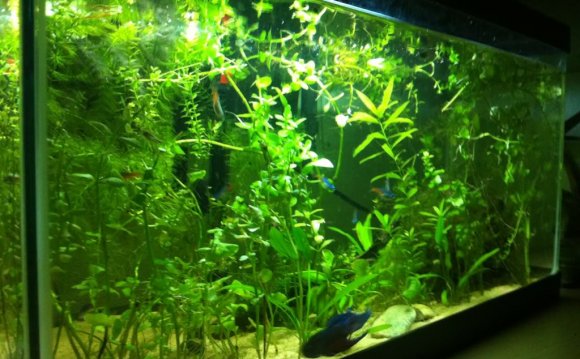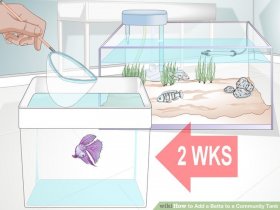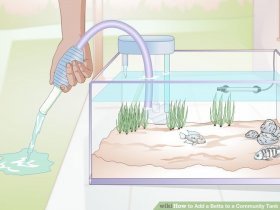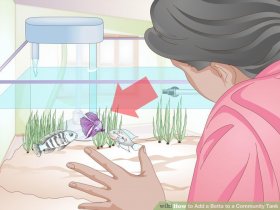

Steps
Method 1
Adding the Fish- Quarantine the betta. Before you add the betta to a community, it needs to be quarantined. This will give you time to monitor the betta’s condition to ensure it does not develop illnesses that it could then spread to the rest of the fish in the community tank. During the two-week quarantine period, ensure that your fish eats properly, demonstrates normal activity, and remains free of signs of parasites.
- If your fish does show signs of illness during the quarantine period, take it to a vet.
- Common symptoms of illness in betta fish include a bloated body or a refusal to eat (constipation), fluffy white growths on its body (fungus), torn or disintegrating fins (fin rot), small white spots on the body or fins (ich), or a grayish slime covering the body or fins (slime disease). Any other behavioral abnormalities or symptoms of illness should be taken seriously and referred to a veterinarian.
- Obtain betta fish from qualified betta breeders. A breeder is more likely to give you a healthy fish than a pet store.
- Ensure your tank is clean. Use visual checks to ensure your tank is free of algae and debris floating on top of the water or settled on the bottom. Ensure your tank’s filter is clean and operating properly. Add a UV sterilizer to reduce the risk of disease. If necessary, change your tank’s water.
- Clean the tank’s gravel by scooping it out and placing it in a sieve, then rinsing it with hot water for a few minutes. Replace it after cleaning.
- Check environmental conditions. The tank’s conditions should be within the parameters a betta fish can tolerate. Check the thermometer to ensure the temperature is between 75 and 82 degrees Fahrenheit (about 26 degrees Celsius). Use your pH meter to make sure the acidity is between 6.5 and 7.5.
- If your tank is too cold, invest in a heat lamp, in-tank heater, or under-tank heater. These are readily available at most pet stores.
- Get a small pH test kit from your local pet store or online to check the pH level.
- If you want to lower the pH level in the tank, you’ll need to add an acidic compound specially designed for fish. Indian almond leaf (IAL) and blackwater extract (BWE) are common additives.
 You could also add peat to your filter and add some untreated wood to your tank.
You could also add peat to your filter and add some untreated wood to your tank. - If you want to increase the pH, add a crushed coral or limestone chip substrate.
- Check your local pet store for materials and compounds to adjust pH levels. Always follow specific use directions when adjusting pH levels. Dramatic changes could negatively impact your fish.
- Acclimate your betta to the community. After the quarantine period is over, your betta is ready to join the other fish. Turn off the aquarium lights and dim the aquarium room’s overhead lights. Transfer the betta to a small plastic bag. Float the bag (with the betta fish still in it) in the water of the community tank for about 15 minutes. Move it slowly and gently through the water.
- This helps the water temperature in the bag approach the water temperature in the tank.
- Fold the top edges of the bag down. The edges of the bag should be rolled down so that they are slightly submerged in the water. The air trapped between the rolled-down edges and the bag should allow the bag (and the betta fish within) to continue floating without your help.
- Add water to the bag. Every four minutes, add about half a cup of tank water to the bag. When the bag is full, dump out half the water from the bag, then float it in the tank again.
 Begin filling the bag with tank water again, adding half a cup every four minutes. When you fill it to the top for a second time, net the betta fish and place it in the tank.
Begin filling the bag with tank water again, adding half a cup every four minutes. When you fill it to the top for a second time, net the betta fish and place it in the tank.
- Dump out the water you placed in the bag.
- Monitor your fish. Keep a close eye on your betta for the first few days after adding it to the community tank. Look for signs that the community arrangement is not working out, such as conflicts between the betta and other fish, or finding your betta fish floating alone in a corner of the tank.
- Have a backup plan before adding the betta to the community tank. If the betta is not accepted by the community, the best backup plan you can enact is to simply transfer the betta back to an individual tank of at least five gallons.
- Major warning signs include missing scales, visible bits missing from the betta’s fins (due to being bitten), disappearance of community fish (due to the betta eating them), or the presence of stress stripes (darkly colored horizontal stripes along the betta’s body).
- Do not confuse stress stripes with a female’s breeding stripes, which are vertical.
Method 2
Choosing the Fish to Add- Choose the sex of your fish. While you can add a female betta to a community with other female betta fish, it is not recommended that you keep male betta fish in the same tank as other males. Males can be extremely aggressive and territorial, especially when they see other betta fish.
- Females are generally less aggressive and territorial than females, but you should keep an eye on any betta fish in your tank - male or female - for problematic behavior.
- Do not attempt to mix male and female betta fish unless you’re trying to breed them. If this is the case, monitor their interactions carefully and separate them at the first sign of conflict.
- Add a curious fish. A community tank offers more opportunity for exploration and enrichment than a solitary tank. Even though betta fish prefer having their own space, they are quite intelligent. A community tank with non-threatening fish, snails, and other creatures will keep the betta engaged and active.
- If you have not already decked your community tank out with fake plants, little fish houses, tubes, rocks, and hidey holes, consider adding some. Betta fish (and other species) enjoy exploring these spaces.
- Do not add aggressive fish to a community tank. While male betta fish, especially, tend to be very aggressive, all betta fish are solitary by nature and can be aggressive if they perceive that another fish is in their zone. Often, the only way to know if your betta would fit into a community tank is to try it. However, if you’ve had your betta in contact with another community before, use that experience as a guide when thinking about whether or not the fish would like to live in another community.
Source: www.wikihow.com









